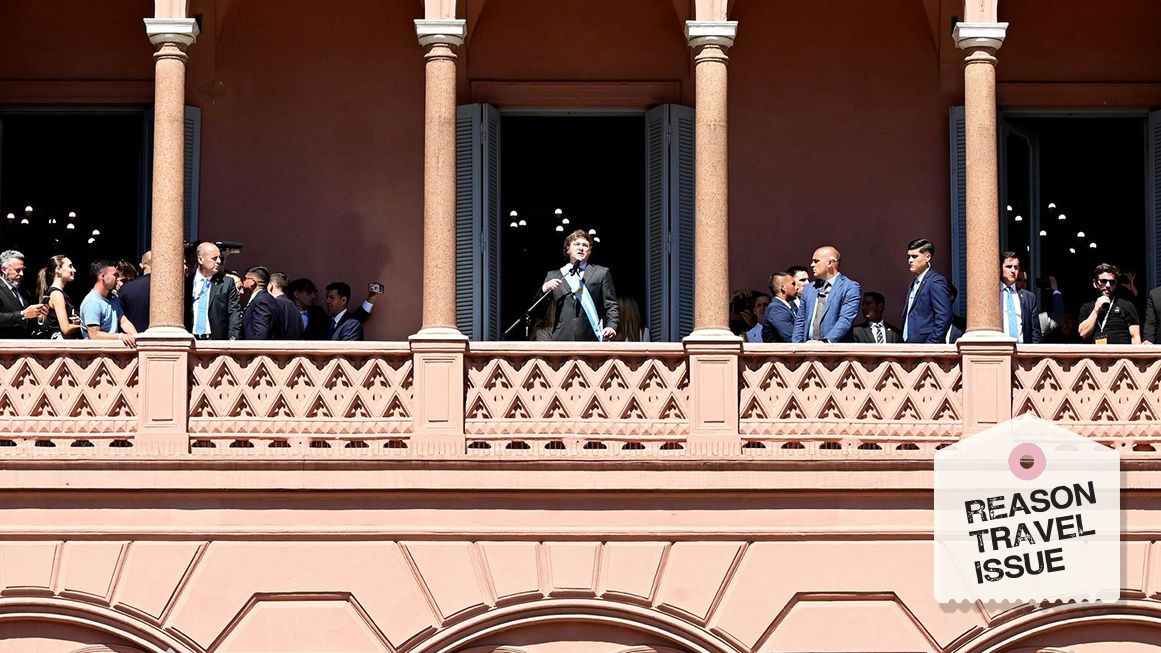A Libertarian Travel Guide to Javier Milei's Argentina
Downtown Buenos Aires is a living testimony to the country's history of freedom and prosperity.

This is part of Reason's 2025 summer travel issue. Click here to read the rest of the issue.
The suggestion that Argentina could be the home of a self-described libertarian president would have seemed far-fetched, to say the least, only a few years ago. Yet today Javier Milei's Buenos Aires is the city where libertarian history is happening.
Buenos Aires wasn't obviously destined to become a beacon of liberty. The city was abandoned not long after the Spanish founded it in 1536. Only after its resettlement in 1580 did the city slowly develop, but not until the 18th century would it flourish as a trade center.
Many downtown sites from the colonial era are worth visiting. As in the United States, the war that led to Argentina's independence started as a protest over free trade—the locals favored it but the Spanish Empire didn't. On May 25, 1810, local representatives met at the Cabildo, right in front of what is today known as Plaza de Mayo, and secured self-government for the first time in Argentina's history.
Casa Rosada (the Pink House), where the Argentine president and his ministers work, is also located on Plaza de Mayo but on the opposite side of the Cabildo. There's a museum, and tours are also available. Visitors to the north side of Casa Rosada might, if lucky, see Milei or some of his ministers as they enter or exit the building.
Downtown Buenos Aires itself is extraordinary for sightseeing. San Nicolás, as the neighborhood is officially known, is a living testimony to the freedom and prosperity that Argentina enjoyed at the end of the 19th and the beginning of the 20th century. It is no wonder that Buenos Aires is known as the Paris of South America: Just walking around downtown and contemplating the Obelisk, the Teatro Colón, and other examples of monumental architecture is an incredible experience—one of the reasons I personally decided to move here.
Those interested in academia should check the schedule of events open to the public at Universidad del CEMA, just over a kilometer north of Casa Rosada. Milei has spoken many times at the college, and many libertarians (myself included) have taught courses there. Whoever visits the university is likely to find many young, enthusiastic students, many of whom will go on to become monetarist economists.
Just a few blocks west of UCEMA is the Centro Cultural Borges, a must-see for book lovers who enjoy fiction. This is a small museum that is dedicated to the memory of Argentina's most well-known writer who also happened to be a classical liberal at heart, Jorge Luis Borges. Tales like "A Weary Man's Utopia," along with countless speeches and conversations, are evidence of Borges' libertarianism and his underlying anarchism.
Before leaving downtown Buenos Aires, visitors can turn north from Centro Cultural Borges and walk a few blocks to Plaza San Martín. All along the way, as tourists exit San Nicolás to Retiro, they'll continue to experience what freedom and prosperity used to look like in Argentina through architecture. Just before arriving at the park from Florida Street, there's a monument to Esteban Echeverría, one of the most important 19th century classical liberals in Argentina. His short story "El matadero" is still taught in schools today as an example of a denunciation of the country's first dictator, Juan Manuel de Rosas.
There's plenty to do outside downtown as well. One place that may be of interest is La Crypta, a bitcoiner mansion that's open to the public, located right in the middle of the quiet Belgrano neighborhood. It's a coworking space as well as a gathering and networking venue for bitcoiners. Crypto scammers have never been, and are still not, welcome. The bitcoiner community, which has been growing in Buenos Aires since the times of triple-digit inflation in Argentina, knows better.
Unfortunately, Buenos Aires was not the birthplace of Argentina's most important classical liberal figure, Juan Bautista Alberdi. Those interested in the intellectual author of the Constitution of 1853, which set the stage for the spectacular decades of immigration and economic growth that once made Argentina wealthy, will have to fly northwest to Tucumán to see the monument dedicated to him as well as the house where the country declared independence in 1816.
For those who can't make it to Tucumán the first time around, perhaps this can be an excuse to come back to Argentina for a second time. We will appreciate it.
This article originally appeared in print under the headline "See Milei's Transformation of Argentina First-Hand."


Show Comments (8)